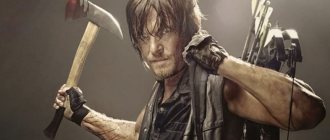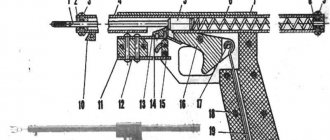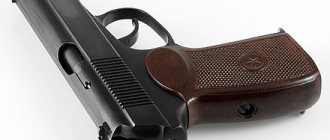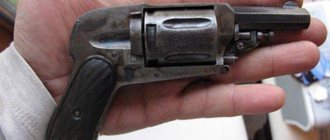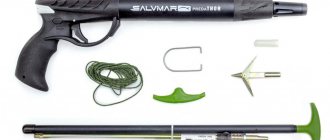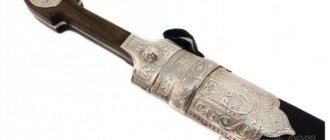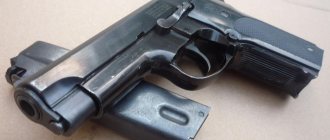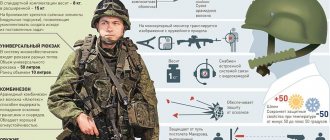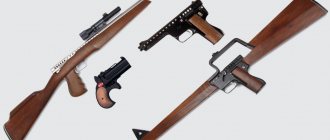The design of this crossbow is so unusual that at first you don’t believe that this is possible.
However, a fact is a fact: inventor Valentin Artemyev from Novosibirsk has created a unique weapon - a multi-shot automatic sports crossbow.
The crossbow-revolver is structurally different from traditional crossbow models in that it is based on an original method of tensioning the bowstring, from which other functional features of the development presented to your attention logically follow. The main distinguishing feature of this design is the principle of a rotating rocking bow, which ensures quick tension of the bowstring and rotation of the drum equipped with several arrows with clear installation of each next arrow into the firing position.
Crossbows of this class can be aimed at shooting at a distance of no more than 30 meters. Of course, the arrow's flight range is much greater, but the inventor has not yet strived for records.
Artemyev's crossbow weighs up to 3.5 kg when fully loaded. In terms of rate of fire, it has no equal among crossbows. (It is clear that any other crossbows shoot only one arrow and then require slow manual reloading). The inventor, without prior preparation, shot a drum equipped with 8 arrows in 18 seconds.
How was such a miracle weapon invented? Yes, apparently, it’s simple: something short-circuited in my head, says Valentin, and it went on and on. First the idea of a revolving bow arose, then the drum was born, and then I decided to fold it like an umbrella. I'm probably not alone in this strategy; and many inventors follow exactly the same pattern. There was just an interest in doing something completely new and unusual. Happened!
History of creation from the inventor
“One day in the smoking room at the factory where I worked,” recalls Valentin, “there was a conversation about the history of weapons and then about crossbows. All of them were inconvenient, since after each shot they required a long reload with the next arrow. I got the idea to create a multi-shot automatic crossbow.
- How did I invent it? I just had an interest in doing something completely new and unusual. Something clicked in my head and off I went. First the idea of a revolving bow arose, then a drum was born in my head, and then I decided to add a crossbow to everything, like an umbrella. I'm probably not alone in this strategy, and many inventors act according to the same scheme. I've been inventing and experimenting for over a year. A modern crossbow, like any small weapon (remember the Kalashnikov assault rifle), should be easy to use, but very reliable. Therefore, it is necessary to work out the clear interaction of all parts and assemblies. The idea turned out to be viable. The world's first repeating crossbow was created and tested.
“My “machine” weighs,” the inventor continues, “in a fully equipped state, about 3.5 kg.” As for range, I aimed to create a sports model. Crossbows of this class shoot accurately at a distance of no more than 30 meters. Of course, the arrow's flight range is much greater, but at this stage I was not aiming for records.
From the editor: Having held the crossbow in my hands, I confirm that this is a miracle of sports weapons technology of the 21st century - beautiful and thought out to the smallest detail. An indirect confirmation of this was the assessment of the crossbow by German crossbowmen, to whom photographs were sent. They just didn’t understand - how could this be? They didn’t understand that Russia had made a qualitative leap in sports weapons technology. (How, in the 19th century, the invention of a drum pistol - a revolver - made small arms automatic). (C)
How to choose a crossbow
Hunting with a crossbow requires a responsible approach to choosing a weapon. The power of a gun dictates its suitability for shooting game of different sizes. There are separate types of weapons for hunting wild boar, bear, elk, hare or fox. Your safety while hunting depends on how correctly you choose your weapon. After all, a wounded but unfinished animal becomes five times more dangerous than a whole and alive one. And from a humane point of view, it is better to kill the game right away so that it does not experience unnecessary suffering. That is why, before you go shopping, you should familiarize yourself in detail with the basis of the device and the existing types of modern tools.
Crossbows are the next stage in the development of small arms after the bow. This weapon looks like a bow that is attached to a rifle-type frame. They tend to be more compact and have better range and accuracy than bows. However, in terms of rate of fire, the crossbow is inferior to its “ancestor”. They are either hand-made or machine-made. During medieval wars, hand guns and special short arrows for them, called “bolts,” were used. This name is still used today in relation to crossbow ammunition. There were also special bullets called “schneper” balls. There were also enlarged models that were used to protect fortresses and have now become an anachronism.
Today, military weapons are a thing of the past, giving way to sporting and hunting weapons. Hunting with a crossbow involves the use of two types of weapons:
- •Block – have special blocks that are located at the ends of the crossbow bow. These blocks allow you to enhance the owner's ability to draw the bowstring due to additional transverse cables. The hunter can easily bend very tight bows.
- •Recursive - this weapon does not have blocks and is characterized by extreme simplicity of design. It is convenient because it does not break and does not require repair or replacement of the bowstring. However, it also has disadvantages - compared to block crossbows, a recurve crossbow does not allow you to independently pull a tight bowstring, throws light arrows and is less effective. To increase efficiency it is necessary to use special devices.
Separately, it would be worth mentioning the Winchester type guns. They are distinguished by a successful lock design, which protects the shooter from any possible accidents when cocking the bowstring. The lock is a sponge-type device that grips the bowstring from behind when cocking the weapon. To cock the crossbow, you need to rest your foot on the stirrup located in front.
Prototype
The prototype is a hollow shaft on which a drum is mounted with several longitudinal guide grooves for laying arrows. At the front end of the drum there is a flange on which a ratcheting device is made, which serves to rotate the drum, as well as to fix it through holes, the number of which corresponds to the number of guide grooves. An eye is pressed into the front part of the hollow shaft, which has a hole located perpendicular to the shaft axis, in which the bracket body with the bow mounted on it rotates freely in a horizontal plane. The arms of the bow are hinged, thanks to which they can fold, freeing the bowstring from tension, and significantly reducing the overall dimensions of the entire structure (when folded, the crossbow fits in a medium-sized case).
This diagram shows side and top views. The numbers indicate:
- 3 – bow, 13 – arrow (bolt),
- 15 – bracket,
- 18 – drum,
- 28-29 – retractable telescopic butt,
- 34 – pistol grip.
The following diagram shows the sequence of actions from pulling the bowstring to firing:
Turn the bow clockwise (or vice versa, depending on the version) until it engages with the trigger rod.
Turn in the opposite direction until it stops (at the moment of turning, the string is tensioned and the next arrow is installed, using a ratchet mechanism, into the firing position).
And the shot (the trigger is activated, and the lowered bowstring throws out another arrow).
Such a scheme ensures fast (about 1 sec.) reloading and bringing the crossbow into combat readiness, due to which the rate of fire increases several times in comparison with traditional designs.
A folding bow and a telescopic stock make it possible to significantly reduce the dimensions of the structure as a whole, while bringing it into working position takes no more than 10 seconds.
Placing arrows directly on the drum (as in a revolver) also significantly reduces the preparatory time for bringing into combat readiness and reduces the reloading process to a simple turn of the bow, during which the drum rotates synchronously, and the next arrow is fixed in combat position.
The bowstring is captured at the end point of the bow's rotation. Its tension occurs at the moment of reverse rotation, and due to the formation of a lever, the tension force of the bowstring is significantly reduced.
This diagram shows the sequence of placing the crossbow in the transport position:
The arms of the bow fold in a horizontal plane.
The arms of the bow are folded in a vertical plane and fixed, the butt is pushed into the central shaft until it stops and is fixed there.
Features of hunting with a crossbow
We can talk about the advantages of hunting with weapons such as a crossbow or bow for a long time and with taste. The main subtleties will impress only lovers and connoisseurs of this weapon, but there are points that are indisputable for any hunter, namely:
- •You do not need to have a special permit to carry these weapons, since this type of weapon is considered a sporting weapon;
- •Hunting with a crossbow is almost silent and allows you to shoot an animal without scaring away all the surrounding game;
- •You can also go fishing with such a weapon;
- •During the hunting process, you are provided with a lot of impressions, up to the feeling of belonging to medieval ancestors, who did not have firearms, but were content with bows and crossbows.
Today, this weapon has undergone significant changes and it is much easier and more convenient to shoot from it than it was in the Middle Ages. Modern guns are equipped with a reliable and simple design, as well as a host of devices to increase power, firing range and reduce various unpleasant effects. But, despite the presence of all the devices, the weapon itself has become lighter. It is so much easier that today many representatives of the fair sex like to hunt with a crossbow. However, there are many more types of such weapons, therefore, when purchasing, it is worth considering a lot of nuances, ranging from the purpose of the weapon to the type of arrows.
DIY pneumatic crossbow from Metro 2033
DIY pneumatic crossbow from Metro 2033
I present to you a pneumatic crossbow based on Metro 2033. The main task was to make it as similar to the original as possible, functional and, of course, with automatic arrow feed. See for yourself what came of it all.
The supporting frame is made of a metal profile which is used for hanging shelves. The strips, 50 centimeters long, are welded together with a gap of 5 mm. This is needed to accommodate the trigger and wires. Two flat parts are welded onto the frame, which act as a receiver; a guide tube on which the drum rotates is welded to one of them. The butt is made of pine block 20x50. The block is glued along the plane with overlap in the corners and reinforced with dowels. A cutout was made to rest on the shoulder, and an “anatomical” handle was formed. Cutouts have been made to resemble the original. On the side, on the right side, a selection is made for the control electronics. To draw wires from the button and valve, an aluminum tube is glued in.
The air container is an oxygen cylinder with a volume of one liter. It is attached to the butt with metal clamps; for this purpose, M6 nuts are glued into the butt. The air valve is used from a car gas equipment. All connections are brake copper tubes with a diameter of 6mm. The tees are brass, also from brake systems. The moving joint is a used brake pipe from my Lancer. To control the air pressure in the system, a pressure gauge of 40 atmospheres is installed. A pump was made for manual inflation, like the original. Pumping up to 10 atmospheres with such a small pump is still a pleasure, so the system has a built-in quick-release connection for quick air filling.
The drum is made entirely of duralumin. Two parts were turned and drilled for attaching the tube-barrels. For accuracy, they were processed by the package. The barrels are duralumin tubes with a diameter of 8 mm and a wall thickness of 1 mm. The barrels are inserted into drilled holes and secured with stoppers.
To rotate the drum, a servo is used, converted into a gear motor. The servo spins a shaft that passes through the entire drum and its tip engages with the cutouts in the drum (initially I wanted to make the drum removable for quick reloading, that’s why it’s so confusing).
A shutter is made to minimize air loss. The servo moves the rod, which enters the barrel. The firing process looks like this: the bolt is closed - the rod is in the barrel, a shot occurs, the bolt opens - the rod comes out of the barrel, the drum rotates, the bolt closes. The process is repeated.
For the tests, for safety reasons, bamboo sushi sticks were used. From a distance of 5 meters, corrugated cardboard penetrates without problems, an apple penetrates right through, an aluminum can resists better, but at a pressure of 10 atmospheres, some arrows also penetrate through. All electronics are controlled by Arduino nano. Power supply: three-cell lithium-polymer battery. The crossbow turned out to be quite weighty, but subjectively it weighed about 7 kg. The balloon takes on the lion's share of the weight.
Source:
pikabu.ru/story/pnevmaticheskiy_arbalet_po_motivam_metro_2033_6490374
25.09.2019
See also:
- How to make a crossbow. Illustrated step-by-step guide
- Paine-Gallway Ralph - Book of Crossbows. History of medieval throwing weapons
- How to make a crossbow. Self-production. Homemade crossbow
- How to make arrow bolts for a crossbow. Illustrated step-by-step guide
- Light up your sun! Original DIY lamp
Rate a homemade product, a master class, an idea. Comments
Ammo selection
Hunting with a crossbow is an activity that requires a sufficient amount of ammunition. It should be remembered that there are hunting and sporting arrows. They are distinguished by different tips, which can sometimes be changed on one arrow. But we recommend buying specialized hunting arrows that have longer fletching. This plumage allows the ammunition to quickly stabilize during flight and almost immediately take up a firing position. The length of such arrows is usually 40-50 cm, and the weight is 30-35 grams. The size and weight of the arrows depends on the animal you are going to hunt:
- •Birds and small animals will require short and light bolts (up to 30 cm and up to 25 grams). Such arrows are usually inexpensive and are made of aluminum and fiberglass;
- •Large animals require specialized steel arrows (40-50 cm and 30-40 grams);
- •If you decide to go fishing with a crossbow, you will have to acquire special needle-shaped harpoon arrows that allow you to easily move underwater. For such arrows, you will also need to purchase an inertia-free reel and a special nylon thread, which is attached to the eye of the bolt.
Usage
Genoese crossbowmen at the Battle of Crecy (1346). Miniature from "Chronicles" by Jean Froissart. XV century
Pieter Bruegel the Elder.
Savage at a masquerade in honor of Orson and Valentine. Woodcut, 1566. The difficult fate of the crossbow was due to the fact that, while decisively superior to the bow in range and accuracy of shooting (at short distances), it also had significant drawbacks - an inconvenient shape, high cost and difficulty in loading.
The high cost limited the spread of crossbows to social boundaries - only wealthy militias could afford such weapons. But the organization of the militia armies of ancient and medieval times was based on a property qualification: rich citizens went on campaigns in armor and fought in close combat, and ordinary warriors used throwing weapons.
However, the crossbow had an undeniable advantage. An archer had to study archery for years when it was enough for a crossbowman to understand the mechanism of reloading and aiming.
Repeating crossbows on a Korean warship from the Imjin War (1592-1598).
Although the penetrating power of crossbow bolts was great, the lever crossbow did not penetrate steel cuirasses, and the speed of the projectile, although greater than that of a bow, remained insignificant in absolute terms. The main advantage of a crossbow over a bow was that crossbow bolts could be made with a reverse taper - in this case, unlike arrows from a bow, they did not get stuck in shields (even if the arrow tip pierced the shield, the shaft still got stuck in it, whereas the reverse taper and short shaft length of the bolt prevented sticking).
Crossbow with an "English collar".
With the exception of the special case of the relatively massive arming of infantry with crossbows in the Han Dynasty, this weapon received real recognition only in Europe from the 14th century, when numerous squads of crossbowmen became an indispensable part of knightly armies. A decisive role in raising the popularity of crossbows was played by the fact that from the 14th century their bowstring began to be pulled by a collar. Thus, the restrictions imposed on the tension force by the physical capabilities of the shooter were removed, and the light crossbow became heavy - its advantage in penetrating power over the bow became overwhelming - the bolts began to pierce even solid armor. At the same time, the gate made it possible to cock the crossbow without much effort.
The worst examples of crossbows, both in Europe and in Rus', were made for a long time with wooden arches, which reduced their advantages over bows to a minimum - to ease of aiming. However, crossbows of an extremely simplified design - with a wooden bow and without a trigger mechanism (the bowstring, when stretched, clung to the gentle protrusion of the stock, from where it was simply pushed with the thumbnail) were in use among poachers until the 17th century. The projectile for such devices was often not an arrow, but a stone or a lead bullet.
The arc of a military crossbow was made first from a conventional bow composite, and later from elastic steel.
Loading a crossbow with a collar.
Hunting crossbow made of ivory.
Crossbows saved the shooter's physical energy compared to bows. Although the tension of a crossbow was many times greater than the tension of a bow (for example, to cock a Chinese crossbow it was necessary to squeeze more than 130 kg), even collarless crossbows were much easier to cock, since different muscle groups are used to cock the crossbow and tension the bow. The bow is pulled by the extensor muscles of the arm and upper back, which are poorly developed in the average person, while the crossbow is cocked by the strongest muscles - the legs, biceps and abdominal muscles. Also, the load was reduced due to the fact that when drawing a bow it was necessary to maintain a balance between strength, accuracy and speed of movement, while for a crossbow only strength was important. As a result, if the tension of a bow has always been limited by the physical development of the shooter, then the tension of a crossbow is mainly limited by the strength of the trigger mechanism.
On the other hand, even light crossbows had a shot energy of up to 150, versus about 50 J for bows. The ability to use a lever, legs, or at least eight fingers (instead of two) to tension the bowstring made it possible, even with a bow twice as short (for lever bows - usually 65 cm, for hand and hook designs - up to 80 cm), to achieve a significant increase in the power of the weapon.
A bolt from a light crossbow could have a weight of 50 g and an initial speed of up to 70 m/s. Such bolts flew at a distance of 250 meters and were dangerous up to 150 meters, and chain mail penetrated from 80 meters, and armor made of leather and iron also penetrated nearby. The bolts of the most powerful lever samples (for example, from gastrofeta) pierced a bronze cuirass from 50 meters.
Even at a short distance, the trajectory of the bolt was, by modern standards, very far from flat, but at ranges close to the maximum, the fire was carried out exclusively with a canopy. For a very long time, crossbows were not aimed in the usual sense - pointing at the target. As a matter of fact, this is precisely why the classic crossbow did not have a butt in the usual sense of the word for us: Chinese crossbows, Roman archubalists, and European crossbows, until the late Middle Ages, were not applied to the shoulder, but were simply held in the hands, giving them what they needed to defeat elevation of the target - when shooting at a group target in a major battle, this was quite enough, but hitting individual targets already required the shooter to have great skill and excellent practical knowledge of the ballistics of his weapon. Europeans apparently began to realize the convenience of placing a long stock against the shoulder during a shot only by the 14th century, and curved butts of the modern type appeared on crossbows in the 16th-17th centuries, already under the obvious influence of firearms, for which, due to their large mass and powerful recoil, this method of retention turned out to be the only possible one.
The rate of fire of a light crossbow (with a lever design) reached 4 rounds per minute. The sighting range of a hunting crossbow was 60 meters, and that of a military crossbow was twice that. The gunsmith of Philip IV Alonzo Martinez de Espinar in his book (1644) reports that military crossbows of the 16th century could kill at 200 steps, hunting ones at 150. Monier de Moral in his book “La chasse au fusil” writes that English crossbowmen hit the target at a distance of 260-400 steps. Good shooters did not miss a chicken egg at a distance of 100 steps, easily beating the legendary “record” of William Tell[9].
The “muzzle energy” of the heavy crossbow has already reached 400 J (for comparison, the Makarov pistol has a muzzle energy of 340 J). The heavy crossbow had an arc of up to 100 cm in span and accelerated a 100 gram bolt to 90 m/s. Accordingly, the firing range reached 420 meters, but the lethal force was only sufficient up to 250, and shooting at a moving target remained effective up to 70 meters. At the same time, chain mail penetrated from 150 meters, light armor from 50-70, and steel cuirasses (together with the chain mail and padded jacket underneath) from 25 meters.
The rate of fire, however, was already only 2 rounds per minute - the gate was worn separately, it had to be attached and detached. And the heavy crossbow itself weighed up to 7 kg (versus 3-5 kg for a light one), required support in the form of a pavez and was serviced by two shooters.
In the 16th-17th centuries, somewhat lightweight crossbows with an integral slatted (“German”) collar and a steel bow were used. The arc length was reduced to 80 cm, and the crew was reduced to one person. The rate of fire was again increased to 4 rounds per minute, but the initial energy of the bolt no longer exceeded 250 J.
A crossbow with a “German collar” - a rack-and-pinion tensioning mechanism.
The flight range of the bolt in the 16th century did not exceed 330 meters. These crossbows no longer pierced the armor of their day - firearms took over the armor-piercing functions, however, by increasing the initial velocity of the projectile and improving the sighting devices, the shooting accuracy became satisfactory up to 80 meters, and at this distance the bolts were quite dangerous.
The great advantage of the crossbow was its high shooting accuracy, comparable only to that of rifled weapons of the 17th-18th centuries. This was achieved not only by ease of aiming, but also by the fact that the string moved in the same plane as the arrow. In addition, as noted above, the crossbow could also have sighting devices.
The design of the projectile also significantly increased the accuracy of shooting - the best archer shot accurately only while he was using his arrows, which he was used to. But he might not have so many of these, and when the archer began to receive government-issued arrows from the convoy, the shooting accuracy dropped significantly. Short crossbow bolts had significantly less pronounced “individuality”. Not only were they much more standard than long booms, but they also had a less displaced center of aerodynamic drag.
The bolts were made short and thick, however, for other reasons. The overload when throwing a projectile from the crossbow's chute would simply break the bow arrow.
Very often in historical and near-historical environments the question arises about the relationship between a crossbow and a bow. Here we have to state that both types of weapons rather than competed with each other, but coexisted, mutually complementing each other. The Arab scientist Ibn Khudayl, who still lived in Spain during the widespread use of crossbows (XIII-XIV centuries), gave an almost exhaustive description of the areas of their use: in his opinion, bows are most suitable for mounted warriors, “as they are faster and less expensive.”
, and crossbows that have an advantage in power and firing range, but have a slow rate of fire - for infantrymen,
“especially in sieges of fortified places, naval battles and operations of this kind”
[10].
The crossbow, due to its power, caused heavy damage. Because of the terrible wounds caused by crossbow bolts, the Catholic Church banned the use of these weapons for some time. True, few people took this ban into account.
Types of crossbows: their advantages and disadvantages
Recurve crossbows are classic models that retain the same design as several centuries ago. The main elements of such models are the arms, consisting of a complete or composite arc, a bowstring and a block. The arc of such a weapon is bent outward - in the direction of the arrow's flight, and the bowstring is simply attached to the ends of the arms. This is an accurate, reliable weapon that weighs only 1.5–3 kg. Fans of the classics should take into account that such models have relatively large dimensions, a hard trigger and strong recoil.
Block crossbows are improved, compact designs that have a more complex tension system: their shoulders are supplemented with special blocks through which a bowstring and two cables are pulled. Using such weapons requires less physical effort than in the case of recursive models. At the same time, the boom speed of block structures is higher than that of classical ones. However, they are quite heavy, which may be a drawback for some shooters.
Excalibur Matrix Mega 405
A fairly powerful model, with an arrow flight speed of 124 meters per second, was presented by a Canadian manufacturer in 2014.
Designed for hunting large animals, and there has long been a joke among hunters that with the help of the Matrix Mega 405 you can get an elephant as a trophy. In addition, it is equipped with a vibration damper and stabilizer, which greatly simplifies shooting.
Having a complex design, it can be easily disassembled and stored in a compact case, which is very convenient for transportation and hiking.
The crossbow is the weapon of the devil.
The name of the pre-firearm throwing weapon, the crossbow, goes back to the German word armustung (weapon for the hands). In French it sounds like a crossbow (arbalete), in English - crossbow (cross-bow), in Italian - balestra (balestra), in Spanish - ballesta (ballesta), in Russian - crossbow. When it comes to a crossbow, they inevitably begin to compare it with a bow, trying to identify the disadvantages of one and the advantages of the other. In a crossbow, all the advantages are obvious, but it is all the more surprising that both the bow and the crossbow existed side by side for a long time. The crossbow is present in all literary monuments of the Middle Ages, if they are talking about war or hunting.
In order to understand all this, you need to look into the past. Man, using the tension energy of a bow to transfer it to the charge released from it, created a very simple and effective weapon. The bow, like the wheel, changed the very existence of man and made his life much easier. The ability to send a deadly blast over a distance gave him the ability to dominate the wild. However, using a bow, man constantly strived to improve this simple weapon. Archery required great physical strength, constant training, and a certain dexterity. When hunting and in battle, one had to wait a long time before firing a shot. In such a situation, holding the bow in a taut position was extremely difficult, as was long-term shooting. What was required was an equally simple and effective weapon, but without the above-mentioned disadvantages. This is how the crossbow became such a weapon. True, he was unable to completely replace the bow, since he added disadvantages to all his advantages, but many of the constructive achievements of the crossbow in the relay race were transferred to firearms. A crossbow, like a bow, is a ranged throwing weapon. Scientists attribute the time of its appearance to antiquity, approximately 400 BC. e. It is believed that a weapon was created in Syracuse, which was a bow mounted on a wooden stock. A hook was used to hold the taut bowstring. In order to draw such a bow, a person had to pull the string with both hands, bending the shoulders of the bow and resting the stock against his stomach. This weapon was called a gastraphet, that is, “charged using the stomach.” To this day, historians argue about what came first - the easel crossbow (throwing machine) or the hand crossbow. Apparently, it can be assumed that the hand crossbow evolved from easel weapons, just as the gun later became a derivative of the cannon. The Greek and Roman throwing machines that used bow tension are well known. These devices were widely used in military affairs. Less is known about similar machines in China. A number of scientists, based on archaeological finds and ancient literary monuments, hypothesize that crossbow weapons appeared in China in the 5th century BC. Thus, trigger devices for arrow-throwing weapons made of bronze were found in China. Still, it seems that the first crossbow devices in China were also easel. It is known that such a device was called shen bi gunn (supernatural bow on a bed). The Chinese are credited with creating both easel multi-bow and multi-shot crossbows. Today it is difficult to say how and where the hand crossbow began to spread. There is evidence that the Franks, who invaded Britain in 457, and also the Goths had such weapons. Since we are primarily interested in hunting weapons, it is worth talking in more detail about a later time, when the crossbow began to take on the appearance of an already established hand-held throwing weapon. The history of the crossbow in Europe begins at the end of the 10th century. From this time on, one can trace the development and technical improvement of the crossbow as a military and hunting weapon. In numerous ancient engravings, the crossbow is depicted in some detail; it is also described in the medieval chronicles of most European countries. In a miniature from the Bible of the late 10th century (collection of the National Library of Paris) you can see two foot archers armed with crossbows. The crossbow's combat advantages played a role in the Battle of Hastings in 1066, when the Norman conquerors defeated the English king Harold II. The king himself was killed in this battle. Often cited are the notes of the learned daughter of the Byzantine Emperor Alexios, Anna Komnenos (1083-1155), entitled “Alexandriad,” which depicts the First Crusade. This learned lady devotes quite a lot of space to the description of the so-called “tzagre”. That's what she called the crossbow. Anna wrote that “tsagra is a bow that is unfamiliar to us.” On this basis, scientists concluded that crossbows were unknown to the Byzantines. It is generally impossible to imagine the Middle Ages of Europe without the image of a crossbowman. Among the knights of the Crusades were squads of crossbowmen. Thus, Richard I, nicknamed the Lionheart, kept crossbowmen in his army. He highly valued this weapon and handled it skillfully. True, it should be mentioned that, according to legend, the king himself fell from a crossbow arrow. In France, the position of granmeter of crossbow shooters was even established, which was slightly lower in rank than a marshal. The crossbow was a constant weapon of mercenaries in the 14th and 15th centuries. The British, Italians and Swiss were considered the best crossbowmen of that time. Many crowned persons of medieval Europe used their services. It was at this time that the victorious march of the crossbow as a weapon began. Specific circumstances contributed to this. As already mentioned, the development of any offensive weapon gave impetus to defensive weapons and the protection of the warrior, which in turn led to new improvements in offensive weapons and so on. The crossbow was just such an offensive weapon. Improving the protection of a warrior in the form of armor, armor and other weapons put forward a requirement to increase the effectiveness of throwing weapons. In the Middle Ages, only a crossbow was capable of hitting such a warrior clad in armor at a distance, provided that his arcs were powerful enough. The crossbow had greater power and shooting accuracy. It was the arches of the crossbow that were given special flexibility and strength. Therefore, as in the bow, crossbow arches began to be made not just from one piece of wood (most often they used yew or ash), but also composited from various types of wood. However, such arcs were installed only on simple weapons that could be easily repaired in the field. The elasticity of wood for a crossbow was not enough, so the bows of powerful crossbows were made from multi-layered horn plates. Such arcs lasted longer and were stronger. And from the 15th century, metal began to be used for crossbow arches. Steel crossbow bows had great elasticity, but quickly broke at low temperatures. It was very difficult, and sometimes impossible, to bend such powerful arcs with just one human muscular strength, even with two hands. For this reason, various devices appear that provide simplicity and ease of loading a crossbow (cocking the bowstring). At the same time, taking into account the tension force of the bowstring, the release system also required improvement. Thus, hand crossbows began to be divided into light and heavy. Light crossbows had a bowstring tension of 50 kg. Heavy - 70 kg. The firing range of such weapons was 400-600 steps. Crossbow arrows were different from bow arrows. They were called bolts. The crossbow bolt was shorter than the arrow and had a stronger and thicker shaft. Its length usually corresponded to the length to which the ends of the arc were bent. The shape and weight of the bolt were always based on precise calculations. The length of the shaft depended on the power of the bow. For long-range performance, the most important requirement was the correct location of the center of gravity. So, for a short bolt, the center of gravity was located at a distance of 1/3 from the tip, for a longer bolt - usually at a distance of 1/4. The center of gravity was checked on each bolt and adjusted. The feathering of the bolt usually consisted of three feathers. It could also be made from leather or rough wood shavings. For expensive hunting crossbows, plates of expensive ivory were used for bolt fletching. The tail was installed straight or at an angle of 15° to impart rotation to the bolt, which increased the accuracy of the shot. Sometimes the feathering on the bolt was not installed at all. The weight of the bolts varied and sometimes reached up to 500 g. Depending on their purpose, the bolts had tips of different configurations. So, to pierce the armor of knights, long and narrow tips with a tetrahedral cross-section were used. The tips were socketed or stalked. With a stalked tip, the shaft of the bolt was tied at the top with a strong cord in order to prevent it from splitting. When hunting they used completely different tips. For hunting small animals and birds, bolts with blunt bullet-shaped or fungal-shaped tips were used. Such bolts suppressed game with the force of impact. A variety of blunt tips were crowned. They were used for hunting large game birds. Bolts with fork-shaped tips were popular among chamois hunters. Chisel-shaped (crescent-shaped) points were placed on bolts for hunting large game. For such hunting, arrow-shaped non-returnable tips were also used. For accurate shooting, a bead was sometimes attached to the tip of the bolt, which served as a kind of front sight. Crossbow bolts were carried in a quiver, most often 12 pieces each. Quivers were made of leather, wood, and metal. Metal quivers were covered with leather or fur. Light crossbows were used for hunting. An effective shot was achieved from a distance of 100-200 m. Often when hunting with a crossbow, hunting dogs were used to drive animals out of the thickets before being shot. Many literary monuments of the past provide detailed information about the use of a crossbow in hunting. Among them, the 14th century work by Gaston de Foix, “The Book of the Hunt,” stands out. This work is often referred to by people studying the history of hunting. Currently, this collection of hunting texts is scattered and stored in parts in museums around the world: the USA, Switzerland, France. Some of the unique sheets are also found here in the Hermitage. First of all, it is worth saying a few words about the creator of this masterpiece. Gaston III, Count of Foix, Viscount of Béarn (historical province in southwestern France) was a person well known for his military prowess and excessive red tape. Viscount Béarn was a prominent man and, according to historians, had an attractive appearance. For his blond and curly hair, the count was nicknamed Gaston Phoebus, that is, Shiny, or Radiant. He was born in 1331, and already in 1343 he replaced his father on the throne. Gaston III became famous primarily for waging successful wars against England. The Count took the art of hunting seriously and demanded the same from his subjects. His farm contained numerous hunting services, in which one of the main places was given to hunting dogs. Suffice it to say that the noble hunter’s kennel was considered perhaps the best in Europe. It contained more than 500 dogs. This extraordinary man was the creator of a unique book. In it he outlined all his hunting experience. The book can also be considered one of the first manuals on proper hunting, containing sections not only on hunting, but also on the behavior and life of wild animals, recommendations on organizing a nursery and keeping hunting dogs, on hunting methods and techniques for using weapons, traps and designs trap. It also outlined training methods for rangers, rules for giving special hunting sound signals, and recommendations for cutting game and preparing dishes from it. Nowadays, such a book would rightfully be called an encyclopedia. The Book of the Hunt by Gaston III was supposedly created in 1370 and was a collection of hunting manuscripts. It is believed that there should have been 44 of them. However, at present the whereabouts of only 33 are known. All texts of the book are accompanied by illustrations of amazing execution and refined, aristocratic taste. It was they who turned the book into a masterpiece of fine art. It is believed that the count's court poet Jean Froissart, one of the best representatives of French literature of the 14th century, took part in compiling the texts of the book. The Book of the Hunt was dedicated to King Philip VI of France. In this literary monument, we are primarily interested in engravings depicting hunting scenes. They show in every detail how and with what they hunted back in the 14th century. It is here that you can examine in detail the bolt tips designed for hunting various game. For small game, blunt tips were used to stun a bird or small animal with a blow. Sharp arrowheads with non-returnable ends were intended for serious game such as deer and wild boar. There are also images of hunters with crossbows on the engravings, which show how the hunt itself was conducted. Time passed, many of the count’s deeds were forgotten, but the name of Gaston Phoebus entered world history thanks to his hunting work. Surprisingly, this is true. The crossbow was a formidable and effective weapon. Its advantages over the bow were obvious. Any person could use weapons, even those who did not have exceptional physical strength. As they said then, a child could cock a crossbow. If a bow required constant training, then any person who picked it up for the first time could shoot from a crossbow. The range and effectiveness of targeted shooting from it were obvious. The crossbow seemed at that time an exclusively destructive weapon that knew no barriers. Suffice it to say that in Europe in the 12th century these weapons were banned by the church. The Second Lateran Council condemned the crossbow as a weapon contrary to God. How serious such a curse was can be judged by the fact that Ecumenical Councils were held only on extremely important issues. True, the ban on the use of diabolical weapons applied only to Christians. The crossbow inspired such fear and apprehension that it happened that secular rulers also prohibited the use of this weapon on the lands under their control. For example, King Conrad III (1138-1152) did this. However, the spread of effective and efficient weapons could no longer be stopped. The crossbow has gained recognition in almost all countries and, it would seem, should have completely replaced the bow, but this did not happen. What's the matter? And the explanation is quite simple. The crossbow, while having significant advantages over the bow, also had disadvantages. It was heavier, it took longer to load, and at the same time, the crossbowman needed cover, and in battle, a larger area. During battle, more archers than crossbowmen could be placed in the same area, which increased the power of the fire. The crossbow was a more expensive weapon to manufacture. The bow's rate of fire was many times higher than it's. A crossbowman fired two arrows per minute, and an archer fired seven. In battle, the crossbowman was usually covered by an assistant with a special shield called a pavez. The archer did not need cover. He was less vulnerable, more maneuverable. Therefore, with the use of a crossbow, the tactics of the battle itself began to change. For efficient shooting, crossbowmen lined up in chains, which were then exchanged one for another. It was their construction that became the prototype of the square. The same tactics began to be used when using the first firearms. With the advent of firearms, the crossbow continued to be a powerful force. The first guns could not compete with it either in range or in the effectiveness of aimed shooting. When France abandoned the use of archers in 1527 and their units were disbanded after the adoption of firearms, crossbowmen continued to remain in service. From the beginning of the 13th century, rifle guilds of crossbowmen began to form in German and Dutch cities. Their patron was St. Sebastian, then St. Moritz. These unions engaged in practical shooting and organized competitions. They also served as the basis for the association of hunters. Since the 13th century, crossbows have become the main hunting weapon, displacing the bow and sling. The crossbow was also used to arm citizens for defense. There is a legend about the Italian Bishop Balsandini. This churchman in 1511 organized the defense of his city of Gubio with the help of citizens armed with crossbows. As a result, the city was saved from plunder. For his feat, the bishop was canonized, and in memory of this event, festive crossbow competitions are still held. The crossbow has been an excellent hunting weapon for centuries. Hunting crossbows were made lighter and smaller in size. Like any hunting weapon, it was characterized by more careful finishing and decoration. Such weapons fell into the arsenals of the nobility and were their pride. Hunting crossbows have always had a butt, a soft trigger and sighting devices. The desire to improve this weapon led to the emergence of more and more new design solutions that made it easier to use the crossbow. Now it was an excellent hunting weapon, silent and effective, it was used by hunters of different classes, including poachers. When the crossbow was removed from armies of armies in many countries, which happened in the second half of the 16th century, it became an exclusively hunting weapon. In England, at the beginning of the 16th century, legislation was repeatedly passed prohibiting the use of crossbows by civilians in royal parks and hunting grounds. Foresters and huntsmen could own this weapon only on the issued permits. To be continued
Hunting and fishing. XXI century
Oleg Malov
https://www.ohotniki.com/new/106.htm
